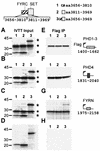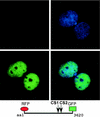Proteolytic cleavage of MLL generates a complex of N- and C-terminal fragments that confers protein stability and subnuclear localization
- PMID: 12482972
- PMCID: PMC140678
- DOI: 10.1128/MCB.23.1.186-194.2003
Proteolytic cleavage of MLL generates a complex of N- and C-terminal fragments that confers protein stability and subnuclear localization
Abstract
The mixed-lineage leukemia gene (MLL, ALL1, HRX) encodes a 3,969-amino-acid nuclear protein homologous to Drosophila trithorax and is required to maintain proper Hox gene expression. Chromosome translocations in human leukemia disrupt MLL (11q23), generating chimeric proteins between the N terminus of MLL and multiple translocation partners. Here we report that MLL is normally cleaved at two conserved sites (D/GADD and D/GVDD) and that mutation of these sites abolishes the proteolysis. MLL cleavage generates N-terminal p320 (N320) and C-terminal p180 (C180) fragments, which form a stable complex that localizes to a subnuclear compartment. The FYRN domain of N320 directly interacts with the FYRC and SET domains of C180. Disrupting the interaction between N320 and C180 leads to a marked decrease in the level of N320 and a redistribution of C180 to a diffuse nuclear pattern. These data suggest a model in which a dynamic post-cleavage association confers stability to N320 and correct nuclear sublocalization of the complex, to control the availability of N320 for target genes. This predicts that MLL fusion proteins of leukemia which would lose the ability to complex with C180 have their stability conferred instead by the fusion partners, thus providing one mechanism for altered target gene expression.
Figures








Similar articles
-
Taspase1: a threonine aspartase required for cleavage of MLL and proper HOX gene expression.Cell. 2003 Oct 31;115(3):293-303. doi: 10.1016/s0092-8674(03)00816-x. Cell. 2003. PMID: 14636557
-
Leukemia proto-oncoprotein MLL is proteolytically processed into 2 fragments with opposite transcriptional properties.Blood. 2002 Nov 15;100(10):3710-8. doi: 10.1182/blood-2002-04-1015. Epub 2002 Jun 28. Blood. 2002. PMID: 12393701
-
The mixed lineage leukemia (MLL) protein involved in 11q23 translocations contains a domain that binds cruciform DNA and scaffold attachment region (SAR) DNA.Curr Top Microbiol Immunol. 1996;211:259-68. doi: 10.1007/978-3-642-85232-9_26. Curr Top Microbiol Immunol. 1996. PMID: 8585957
-
Biphasic MLL takes helm at cell cycle control: implications in human mixed lineage leukemia.Cell Cycle. 2008 Feb 15;7(4):428-35. doi: 10.4161/cc.7.4.5426. Epub 2007 Dec 6. Cell Cycle. 2008. PMID: 18235233 Review.
-
Structure of AF3p21, a new member of mixed lineage leukemia (MLL) fusion partner proteins-implication for MLL-induced leukemogenesis.Leuk Lymphoma. 2001 Aug;42(4):595-602. doi: 10.3109/10428190109099319. Leuk Lymphoma. 2001. PMID: 11697487 Review.
Cited by
-
Species selectivity of mixed-lineage leukemia/trithorax and HCF proteolytic maturation pathways.Mol Cell Biol. 2007 Oct;27(20):7063-72. doi: 10.1128/MCB.00769-07. Epub 2007 Aug 13. Mol Cell Biol. 2007. PMID: 17698583 Free PMC article.
-
Ten members of the Arabidopsis gene family encoding methyl-CpG-binding domain proteins are transcriptionally active and at least one, AtMBD11, is crucial for normal development.Nucleic Acids Res. 2003 Sep 15;31(18):5291-304. doi: 10.1093/nar/gkg735. Nucleic Acids Res. 2003. PMID: 12954765 Free PMC article.
-
The molecular biology of mixed lineage leukemia.Haematologica. 2009 Jul;94(7):984-93. doi: 10.3324/haematol.2008.002436. Epub 2009 Jun 16. Haematologica. 2009. PMID: 19535349 Free PMC article. Review.
-
The pathogenesis of mixed-lineage leukemia.Annu Rev Pathol. 2012;7:283-301. doi: 10.1146/annurev-pathol-011811-132434. Epub 2011 Oct 17. Annu Rev Pathol. 2012. PMID: 22017583 Free PMC article. Review.
-
Menin Associates With the Mitotic Spindle and Is Important for Cell Division.Endocrinology. 2019 Aug 1;160(8):1926-1936. doi: 10.1210/en.2019-00274. Endocrinology. 2019. PMID: 31211356 Free PMC article.
References
-
- Armstrong, S. A., J. E. Staunton, L. B. Silverman, R. Pieters, M. L. den Boer, M. D. Minden, S. E. Sallan, E. S. Lander, T. R. Golub, and S. J. Korsmeyer. 2002. MLL translocations specify a distinct gene expression profile that distinguishes a unique leukemia. Nat. Genet. 30:41-47. - PubMed
-
- Ayton, P. M., and M. L. Cleary. 2001. Molecular mechanisms of leukemogenesis mediated by MLL fusion proteins. Oncogene 20:5695-5707. - PubMed
-
- Breen, T. R., and P. J. Harte. 1993. Trithorax regulates multiple homeotic genes in the bithorax and Antennapedia complexes and exerts different tissue-specific, parasegment-specific and promoter-specific effects on each. Development 117:119-134. - PubMed
-
- Butler, L. H., R. Slany, X. Cui, M. L. Cleary, and D. Y. Mason. 1997. The HRX proto-oncogene product is widely expressed in human tissues and localizes to nuclear structures. Blood 89:3361-3370. - PubMed
Publication types
MeSH terms
Substances
Grants and funding
LinkOut - more resources
Full Text Sources
Other Literature Sources
Molecular Biology Databases
